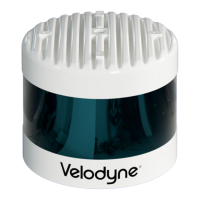Appendix J • Network Configuration
Your sensor generates lots of data which it transmits via Ethernet. This section covers various aspects of this interface and
how to connect and configure it. It also touches on the situation where you have more than one sensor on the same net-
work.
J.1 Ethernet and Network Setup
128
J.1.1 Defaults
128
J.1.2 Establishing Communication via Ethernet
128
J.2 Network Considerations
129
J.2.1 Throughput Requirements
129
J.2.2 Single Sensor Transmitting to a Broadcast Address
130
J.2.3 Multiple Sensors in the Same Network
130
J.1 Ethernet and Network Setup
The RJ45 Ethernet connector on the Interface Box connects to any standard 100 Mbps Ethernet NIC or switch with MDI
or AUTO MDIX capability.
J.1.1 Defaults
Each sensor’s IP address is set at the factory to 192.168.1.201.
By default, the sensor sends UDP data packets to broadcast address 255.255.255.255.
Note: Each sensor has a unique MAC Address and Serial Number set at the factory by Velodyne LiDAR that cannot be
changed.
J.1.2 Establishing Communication via Ethernet
The instructions below are for Windows computers. For linux or Macintosh computers, perform equivalent steps (not spe-
cified here).
1. Connect the computer to the Interface Box with an Ethernet cable.
Velodyne recommends disabling WiFi on your computer to avoid possible network conflicts.
2. Provide power to the sensor.
3. Open your computer’s Network/Ethernet settings page.
4. Select Internet Protocol Version 4 (TCP/IPv4).
5. Select the Use the following IP address: function.
The sensor requires a static IP address.
6. Enter the following IP address: 192.168.1.XXX. See
Figure J-1 on the facing page
.
“XXX” can be any number from 2 to 254 except 201.
128 VLS-128 User Manual

